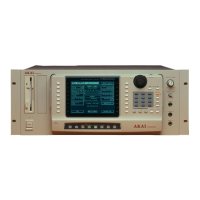166 Version 1.21
EDIT SAMPLE
s5000
/
s6000
Furthermore, the PRESET parameter has a ‘window’ function that
provides access to an ADJUST parameter.
Sometimes, our presets may not quite satisfy your needs and some
kind of ‘manual override’ is required. This is the ADJUST control. The
ADJUST parameter gives access to the key parameters in any one preset
and allows you to ‘tweak’ the preset with one, easy to use control. There
are no strict rules to using this control other than if the selected preset
gives you almost acceptable results but there are few glitches in the
processed sound, try tweaking the ADJUST control and do it again to
see if this improves things.
The basic rule of thumb for using the ADJUST parameter is that a positive
value will help improve high frequency and percussive sounds whilst
negative values will help in improving bass notes. So, for example, if the
timestretched sample has a lot of percussive transients which are
‘flamming’ , try setting a positive value to improve things. This may,
however, cause lower frequency sounds, especially sustained bass parts,
to ‘wobble’ slightly. Conversely, if the bass end is more important and
the processed version exhibits any ‘wobble’, try setting a negative value
(although be aware that this may upset high frequency percussive
transients).
Pressing STRETCH SAMPLE will initiate the timestretch. You will see the usual “Processing sample”
progress display followed by the PLAY/KEEP ORIGINAL/NEW/BOTH and RENAME prompt.
Respond accordingly.
NOTE: When timestretching a sample that has loops, you may find that the processed versions
loop points are slightly disrupted and exhibit clicks. To overcome this, visit the LOOP page and
try AUTO FIND and/or a CROSSFADE - this should restore the loop fairly easily. However, a
bit of work may be necessary to get a perfect loop again.

